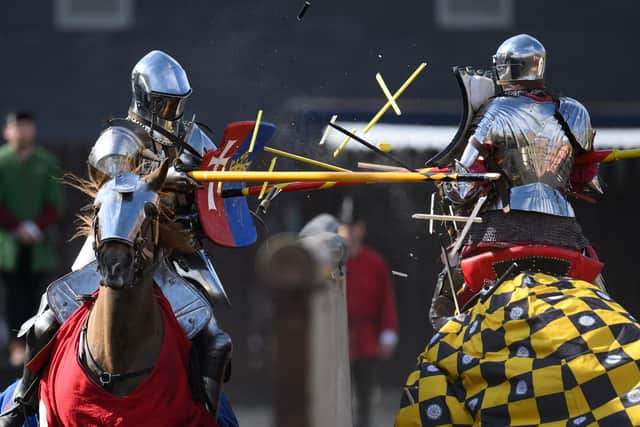How Scottish rebels shocked Europe by murdering the drop-dead gorgeous flower of 16th-century chivalry
James IV really knew how to throw a good tournament, that cross between the Euros and a music festival, with tents, music, and high-impact sporting action. All they needed were the chemical toilets. Like world-class football, the tournament world was highly competitive, and potentially lucrative. There were prizes of horses, gems and purses heavy with gold. Perhaps even the chance of a kiss from a queen.
In 1502, word came to James of a knight who was cleaning up in the lists, a dazzling young Frenchman touring Europe basically looking for a fight. He was appearing at all the major tournaments like a chart-topping rock star.
Advertisement
Hide AdAdvertisement
Hide AdHis name was Sir Antoine D'Arcy, De La Bastie. The romantic Arthurian legends were all the rage at the time, and it shows. His stage name was The White Knight. He fought in shining silver armour and wore the colours of Anne of Brittany, Queen of France. Also, he was drop-dead gorgeous. He famously wore his hair long, plaited with a white ribbon laced through those glorious locks.


Showered with gifts
James immediately sent out the call. “All and sindrie his lordis, earleis, and barrouns …justing or tornament to come to Edinburgh to him.” The White Knight couldn’t refuse. He was a hit at the king's wedding tournament, and returned in September 1506. The king was clearly thrilled, splashing out 21 shillings a week to lodge him at James Aikman’s house.
He faced James Hamilton, the Scottish champion, more than once. The home crowd must have been thrilled when the local boy held the Frenchman to at least one nil-nil draw. De La Bastie won enough times to accrue a small fortune in prize money. The king was so delighted with Antoine that he showered him with gifts of saddles, silver goblets and more cash. James even paid to have the hooves of the White Knight’s horse bathed in wine. Nice gesture, but probably pretty useless in equine terms. De la Bastie headed back to France laden with the glories and gold of a good jousting season. He really should have stayed there.
James IV, the king who adored knights and tournaments, was cut down on Flodden Field in 1513. His widow, Margaret Tudor, fought to be regent for her infant son, but in the end, she lost. John Stewart, Duke of Albany left his home in France to take control of the kingdom. By his side was his friend. A familiar figure to tournament fans everywhere. Sir Antoine D'Arcy, De La Bastie. Good move. The White Knight was just as nifty on the battlefield as he was in the lists.
Heads on spikes
Of course, taking control of Scotland was one thing. Holding onto it was quite another. It didn’t take long for one great Borders family to cause trouble. The Homes. Albany dealt with this by extending safe conduct to Alexander Lord Home, and his brother William. Come to Holyrood, he said. Let's sort this little difficulty out. It was. Alexander and William were beheaded in Edinburgh on October 8, 1516. For good measure, the severed heads were stuck on spikes at the Tollbooth.
Naturally this gave the Homes a very jaundiced view of Albany. They were even less chuffed when he appointed his French friend Lord Warden of the Marches, a title the Homes considered theirs. They nursed their grievances until Albany left for a visit to France.
On September 17, 1517, the Homes somehow lured De La Bastie away from the heavily fortified castle at Dunbar and ambushed him near Duns. He cut free from the melee and headed towards the ford at the Whiteadder River and safety. He never made it. He was chased into what the chronicler Lindsay of Pitscottie describes as a “flow-moss”, a wet peaty bog. Treacherous for a heavily armoured man mounted on a big battle charger. Not nimble, these beasts, and this one hadn’t even had its hooves washed with the king's wine. The horse slid, stumbled, and threw De La Bastie.
All the tournament glories and kisses from queens couldn’t save the White Knight now. The Homes fell on De La Bastie, tore away his helmet and butchered him. They hacked his head off, and threw his corpse into a hole in the ground. Another chronicler, John Leslie, claims the head was nailed to the mercat cross in Duns, a public grisly tribute to Sir Alexander and William. David Home, Laird of Wedderburn, was very taken with De La Bastie’s long hair. He had it cut off and “knit” to his saddle.
Advertisement
Hide AdAdvertisement
Hide AdFrench king sends army
There was an international uproar. You can’t go around murdering flowers of French chivalry and dumping their bodies in unhallowed graves without some kind of payback. The King of France himself gave Albany 3,000 men to go and sort out the Homes, and anyone else who got in the way.
The Laird of Wedderburn fled to England, leaving behind a skull that, according to a local ballad, finally rotted and fell apart. The plait of long dark hair is said to have survived in Wedderburn Castle until 1810, when Miss Jean Home, a sensible woman, threw it into the fire. Just as well. The castle is now a lovely wedding venue. No bride wants the mouldering pigtail of a long dead knight about the place.
That should have been the last remains of De La Bastie, but somewhere there are bones in the ground. There are clues to where they lie. For hundreds of years, a field in the area was known as “De La Bat’s field”. In the early 19th century, General James Home erected a monument to the slain Frenchman, at Preston, in the Scottish Borders. The headless body of the White Knight may well be nearby.
Comments
Want to join the conversation? Please or to comment on this article.

